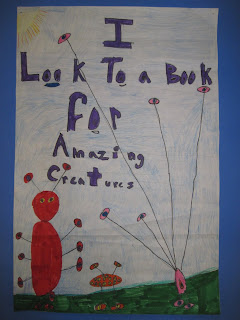

Ooh, what fun! Fingerpaint! Last week my sweet kindergarten students fingerpainted, and today we created creatures of all sorts - dragons, aliens, cats, unicorns, and totally new inventions. After all, it was Funky Friday!
We started by cutting our fingerpainting into a body for our creature, and then we dug into piles of end-of-year scraps, where we found everything from patterned paper, corrugated cardboard, and chunks of cereal boxes. We cut and glued enthusiastically, as you can see in these photos.



We've decided to add to them a little more in our next art class, gluing where necessary, but also using crayons to create an environment for the creature. We couldn't have done this project back when school began - boy have these kindergartners grown up.



Meanwhile, it was quite a busy eventful day in the art room, because after 12 weeks, it was my student teacher's last day. The kids will miss her. Jess, if you are reading this, you did a great job! Maybe next week (with her permission) I'll post some of the beautiful pointilist perspective city and country street scenes that the 5th graders painted while she was here teaching. The kids loved stamping away with long Q-tips.
Then I stayed after school for a LONG time setting up for a sub, so that Tuesday I can go on a field trip with the 2nd graders to the Teddy Bear Factory in Vermont. We'll be taking a ferry ride across Lake Champlain in one direction and the kids are oh so excited. I guess we'll need to draw and paint some teddy bears next week.
Congrats to those of you who have completed the end of your school year - we're still in session till June 24th...























































